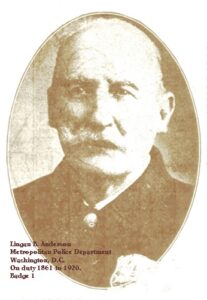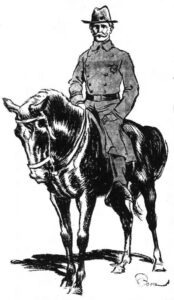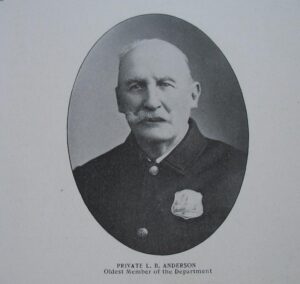1861-1865
"The Civil War Years"

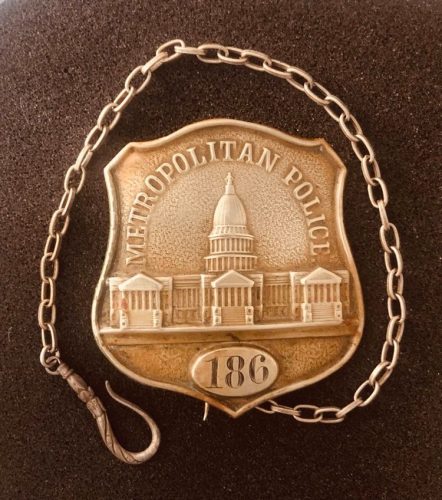
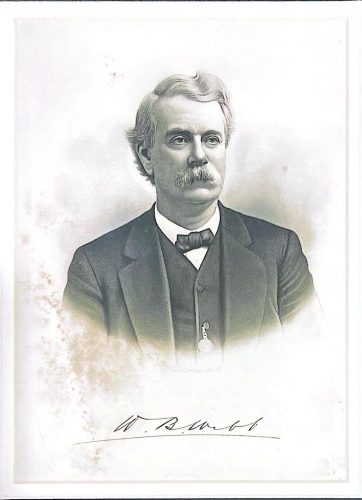
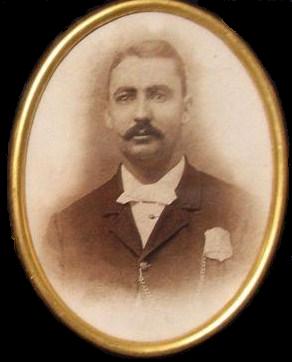
The Original 1861 Metropolitan Police Department
Signed in on August 6th, 1861 – Sworn in September 11th, 1861 Several Officers were not appointed until the 12th of September they will be noted with a single “ * “ next to their name. Within a few weeks it was complete, those hired after the 11th/12th were noted with double “ ** “
1st Precinct: 1861
Sergeant: Charles Barker
Patrolman
L. B. Anderson
Isaac Cline
David Cole
R. J. Mc Clellan
James Mylloy
E. Simpson
G. W. Duvall
2nd Precinct: 1861
Sergeant: David Miller
Patrolman
Thomas R. Benson
Nathan Burnham
Jost. T. Morgan
Jno. W. King
L. O. Boose
Jno. W. Pool
Tobias Talbert
3rd Precinct: 1861
Sergeant: John H. Newman
Patrolman
R. T. Chick
C. Sebastian
JNO. Drill
Ausustine Brown:
George B. Lipscomb
J. N. W. Davis
Jafferson Robinson
Sam’l Fearson
R. B. White
JNO. T. Findley
C. L. Boardman
Chas. E. Cameron
T. F. Evans
J. W. Harry
JNO. T. Essex
G. W. Hurdle
WM. T. Riley
R. S. Jones
W. T. Robinson
Randall Colburn
Martin Donohue
4th Precinct: 1861
Sergeant: W. S. Hurley
Patrolman
S. L. Calhoun
Simeon Garrett
Michael Roche
JNO. Borland
J. J. Calvert
Alexander Clements
J. C. Mansfield
Napoleon Bouvet
Geo. Chism
J. H. Godfrey
W. H. Forrest
Daniel Crump
A. D. Barron
5th Precinct: 1861
Sergeant: Richard M. Dower
Patrolman
B. M. Reed
Alexander Tait
G. H. Walker
Joseph Sessford
Jast. T. Ferry
WM. H. Gibson
Thos. Shaksphere
Robt. Bunton
P. M. Keating
W. H. Troxell
Jas. Sullivan
J. W. Mattingly
T. W. Belt
M. O’Connor
A. P. Harriman
Michael Healy
Thomas Brit
6th Precinct: 1861
Sergeant: Jedediah Gittings
Patrolman
W. B. Downing
C. M. Skippen
J. W. Glower
J. T. Shield
Cornelius Noonan
W. M. Kelly
Jas. Lewis
Alexander A. Greer
C. J. Cook
[J. F. Parker]
Thomas J. Steele
Henry Botoner
JNO. C. Heise
G. W. G. Elsin
H. B. Curtis
A. W. Johnson
Albert Brewer
Eneas Reynolds
Robt. Johnson
John Hammond
7th Precinct: 1861
Sergeant: A. T. Donn / Fred Depro
Patrolman
JNO. R. Cronin
W. B. Turner
E. M. Boteler
Jaco Shearer
Peter McGraith
S. T. Crown
Jas. Handley
Josiah Esses Jr.
John F. Kelly
Adolph Eckloff
J. B. Walling
R. M. A. Fenwick
T. F. Pendel
Daniel Hannan
JNO. Leach Jr.
William Drane
A. R. Allen
JNO. F. Lynch
Jas. McColgan
B. F. Morris
C. W. Thompson
W. W. Grant
8th Precinct: 1861
Sergeant: James V. Bryan
Patrolman
J. H. Richards
WM. Middleton
Goodwin Pierce
Hugh Copeland
R. A. Miller
Robert Brown
R. A. Milstead
M. Meridith
John Wilson
J. B. Conway
F. H. Sage
9th Precinct: 1861
Sergeant: Edward Wayson
Patrolman
C. C. Clark
R. Pumphrey
J. O. Lusby
J. F. Speiser
WM. Hutchinson
George Atchenson
C. H. Krause
P. W. Harbin
W. H. Fuss
S. E. Arnold
10th Precinct: 1861
Sergeant: H. C. Hepburn
Patrolman
W. G. Brock
J. D. Hutton
WM. Weedon
H. A. Garrett
F. A. Boswell
Robert Campbell
C. R. Vernon
J. W. Gessford
B. T. De Vaughn
James Monahan
WM. M. McCauley
B. F. Barker
S. T. Larcomb
J. A. W. Clarvoe
Charles Ashton
C. W. Harman
WM Gibson
J. R. Harrover
T. A. Clements
W. S. Kneas
M. B. Gorman

Interesting facts regarding the Metropolitan Police Department
Under the provision for the appointment of Special Policeman, W.S. Kneas was the first person commissioned.
Mounted men were allowed $250 a year for forage.
The Superintendent uniforms adopted in the early days were not as gorgeous as those that have since taken their place. The Superintendent wore a frock coat with police buttons, the Sergeants double-breasted frock coat and blue pants, while the Patrolman were attired in navy blue coats with rolling collars and nine buttons, two fastened at the hips and two on the skirt, blue waistcoats, and pants with white cords down the seams. Coats were to be buttoned at all times when officers were on duty, and hats were the official headgear for all members of the force.
One of the first instances of breach of discipline which was called to the attention of the board was that of a sergeant, who was arraigned for accepting twenty dollars for the arrest and return to his master of a fugitive slave.
1861
The First MPD Uniform:
150 years ago this week, to start 1862 off on the right foot, Washington’s finest debuted new uniforms. The new uniforms were described with effusive praise in the December 31, 1861 edition of the Washington Evening Star: “The Metropolitan Police will appear in full uniform on the 1st of January. The cap is of blue cloth, of a very small pattern, and apparently well adapted to the service for which it is intended. The coast is of dark blue cloth, made as an over-coat, double-breasted, with two rows of handsome gilt buttons, upon which within a handsome wrought wreath appears the initial letter ‘P’ in the old English character. The coats for the sergeants and patrolmen differ only in the fact that upon the back skirt of the coast the former have six of these buttons, and the patrolmen have four. The pants are of the same colored cloth, with a neat white worsted coast in the sideseams. The staffs intended for use upon special occasions are similar in form to the one in common use, but are more handsomely turned, of rosewood and polished. The entire outfit is a very great improvement upon the uniform of the police.
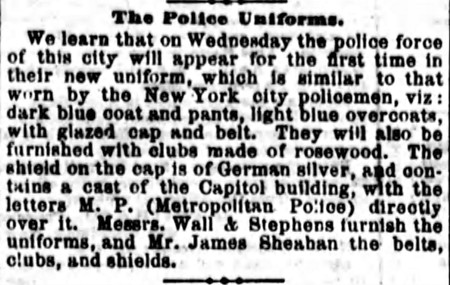
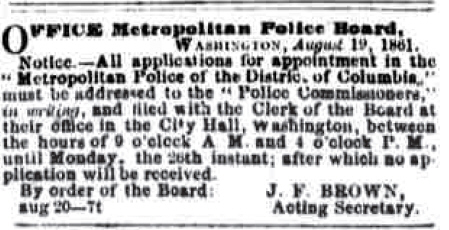
1862
1862 – The first accident (negligent) discharge occurred in the Second Precinct (Georgetown), when patrolman Levi Boose dropped his service pistol and shot patrolman William Andrews, seriously wounding him, (MPD).
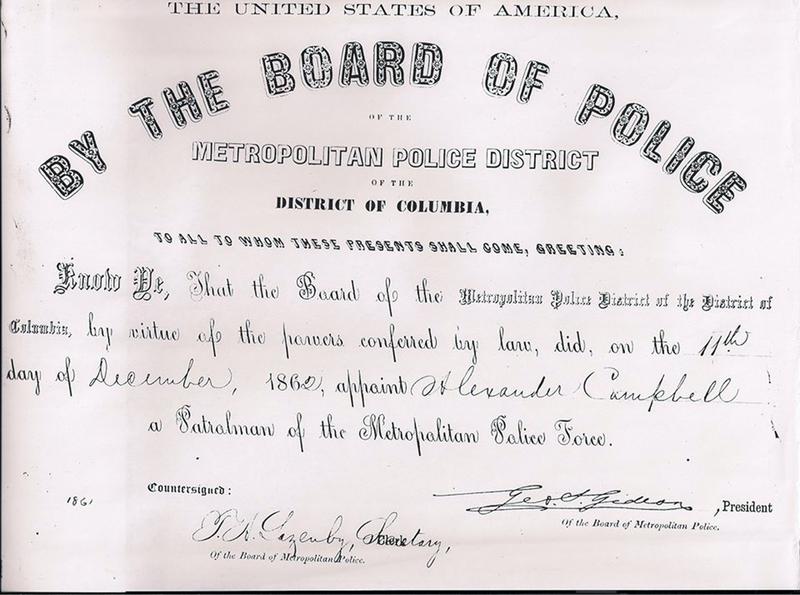
1863
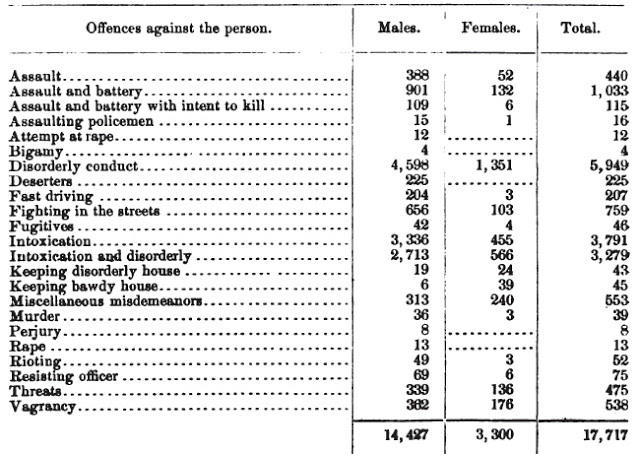
1865
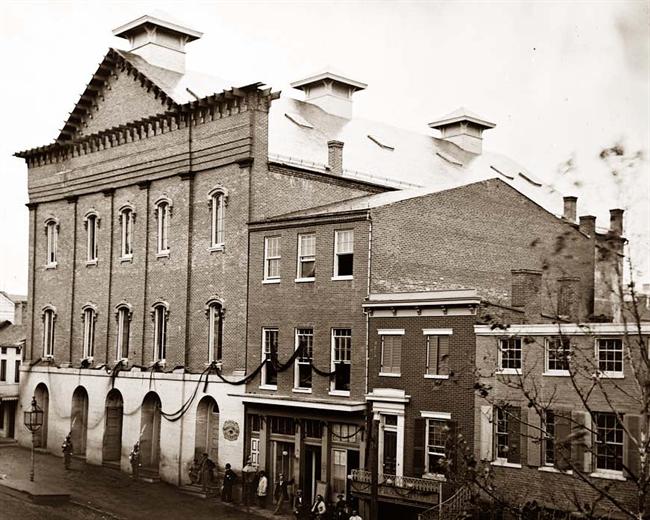
Ford theate where President Lincoln was shot. Attached and to the right where the “X” is, is the STAR SALOON where Lincolns M.P.D. bodyguard John Parker is believed to have been when Lincoln was shot
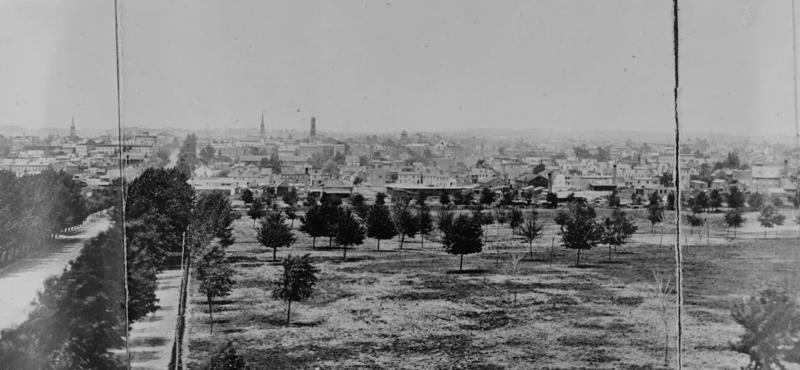
An 1865 panoramic view of Washington D.C.
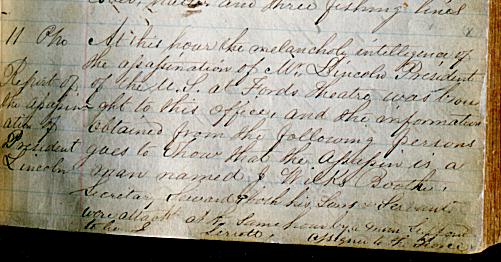
On the evening of April 14, 1865, a Metropolitan Police detective recorded into the record what probably remains the most infamous case in the Department’s history: “At this hour the melancholy intelligence of the assassination of Mr. Lincoln President of the U.S. at Fords Theatre was brought into this office and information obtained … goes to show the assassin is a man named J Wilks Boothe.” Just a month earlier, 119 Metropolitan Police officers had headed up the presidents second inaugural procession. (National Archives)n the evening of April 14, 1865, a Metropolitan Police detective recorded into the record what probably remains the most infamous case in the Department’s history: “At this hour the melancholy intelligence of the assassination of Mr. Lincoln President of the U.S. at Fords Theatre was brought into this office and information obtained … goes to show the assassin is a man named J Wilks Boothe.” Just a month earlier, 119 Metropolitan Police officers had headed up the presidents second inaugural procession. (National Archives)
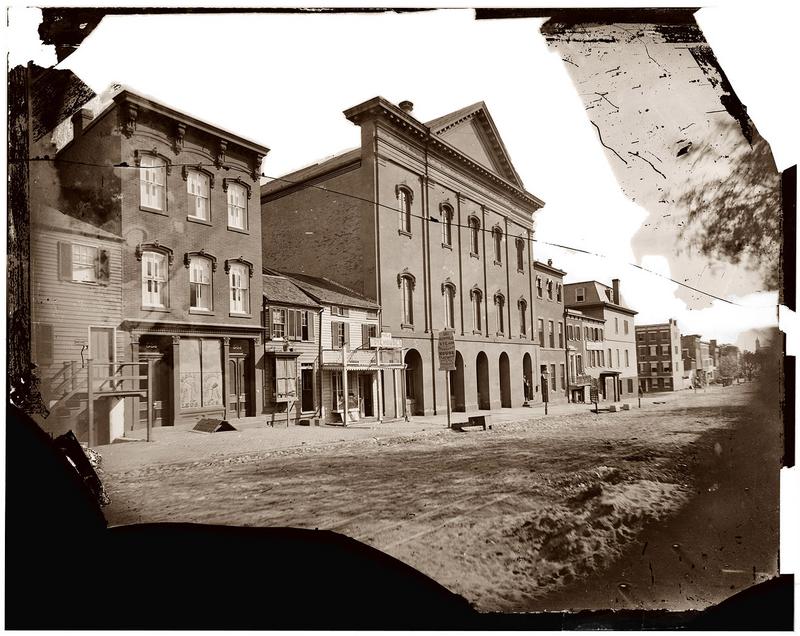
Another 1865 view of Ford Theatre
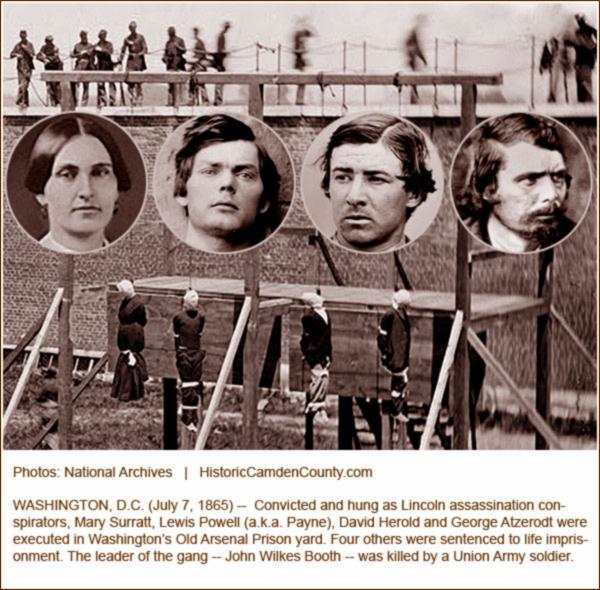
The first women executed by the United States Government, Mary Surratt, was hanged on the grounds of the old arsenal (present day Fort McNair), for participating in the conspiracy of President Lincoln’s assassination. She is buried in Mount Olivet Cemetery.
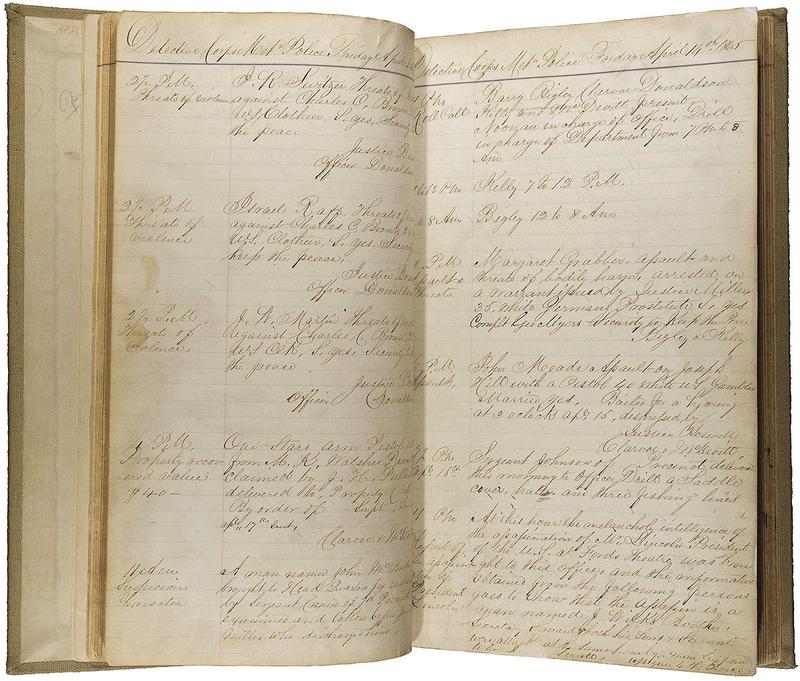

MPD Logbook for the Lincoln Assassination
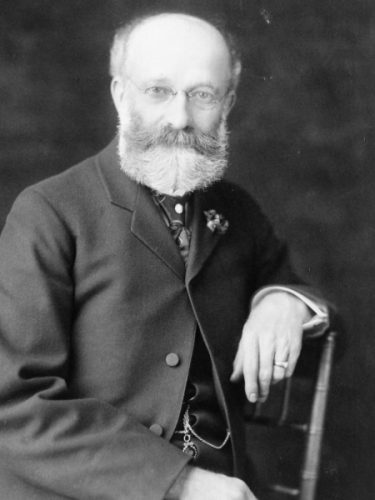


This member of the M.P.D. is William Crook. Officer Crook was assigned to the White House to protect several Presidents including President Lincoln. Crook was not on duty the night Lincoln was shot.

